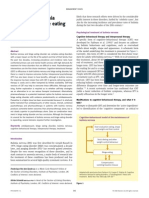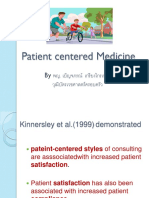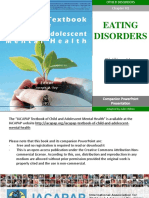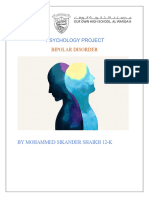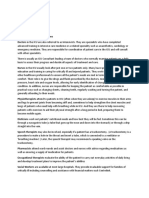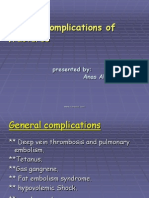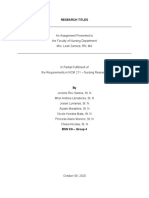Psychiatric Disorders
Psychiatric Disorders
Uploaded by
arinahedianaCopyright:
Available Formats
Psychiatric Disorders
Psychiatric Disorders
Uploaded by
arinahedianaOriginal Description:
Copyright
Available Formats
Share this document
Did you find this document useful?
Is this content inappropriate?
Copyright:
Available Formats
Psychiatric Disorders
Psychiatric Disorders
Uploaded by
arinahedianaCopyright:
Available Formats
Deirdre Ryan, MB, BCh, BAO, FRCPC, Xanthoula Kostaras, BSc
Psychiatric disorders in the
postpartum period
Postpartum mood disorders and psychoses must be identified to
prevent negative long-term consequences for both mothers and
infants.
ABSTRACT: Pregnant women and
their families expect the postpartum
period to be a happy time, characterized by the joyful arrival of a new
baby. Unfortunately, women in the
postpartum period can be vulnerable to psychiatric disorders such as
postpartum blues, depression, and
psychosis. Because untreated postpartum psychiatric disorders can
have long-term and serious consequences for both the mother and
her infant, screening for these disorders must be considered part of
standard postpartum care.
he three psychiatric disorders most common after the
birth of a baby are postpartum blues, postpartum depression, and postpartum psychosis.
Depression and psychosis present
risks to both the mother and her infant,
making early diagnosis and treatment
important. (A full description of pharmacological and nonpharmacological
therapies for these disorders will
appear in Part 2 of this theme issue in
April 2005.)
Postpartum blues
Postpartum blues refers to a transient
condition characterized by irritability,
anxiety, decreased concentration, insomnia, tearfulness, and mild, often
rapid, mood swings from elation to
sadness. A large number of postpartum women (30% to 75%) develop
these mood changes,1 generally within 2 to 3 days of delivery. Symptoms
peak on the fifth day postpartum and
usually resolve within 2 weeks.2 Typically, providing support and reassurance to the new mother and stressing
the importance of adequate time for
sleep and rest will be sufficient treatment for postpartum blues. The use of
minor tranquilizers at low doses (e.g.,
lorazepam 0.5 mg) may be helpful for
insomnia. Careful monitoring during
this period is essential, since a small
100
BC MEDICAL JOURNAL VOL. 47 NO. 2, MARCH 2005
proportion of women with postpartum
blues may develop postpartum depression.3
Postpartum depression
The Diagnostic and Statistical Manual of Mental Disorders, Fourth
Edition, Text Revision (DSM-IV-TR)
defines postpartum depression (PPD)
as depression that occurs within
4 weeks of childbirth.4 However, most
reports on PPD suggest that it can
develop at any point during the first
year postpartum, with a peak of incidence within the first 4 months postpartum.1 The prevalence of depression
during the postpartum period has been
systematically assessed; controlled
studies show that between 10% and
28% of women experience a major
depressive episode in the postpartum
period, with the majority of studies
favoring a 10% figure.5
Several key risk factors have been
identified as major contributors to the
development of PPD, including:
A history of postpartum depression.6
A history of depression before conception.7
Dr Ryan is a consultant psychiatrist in the
Reproductive Mental Health program at BC
Womens Hospital and St. Pauls Hospital.
Ms Kostaras is a research assistant in the
Reproductive Mental Health program.
Psychiatric disorders in the postpartum period
A family history of depression, particularly PPD.7,8
In addition, several other factors
may contribute to the development of
PPD, including poor social support,
the experience of adverse life events
during the postpartum period, marital
instability, young maternal age, and
infants with health problems or perceived difficult temperaments.
Symptoms of PPD are similar to
the symptoms of a major depressive
episode experienced at any other time
(see the Table ). There are, however,
subtle differences, including:
Difficulty sleeping when the baby
sleeps.
Lack of enjoyment in the maternal
role.
Feelings of guilt related to parenting
ability.
Table. Criteria for a major depressive
episode.
A.Five or more of the following symptoms*
must be present daily or almost daily for
at least two consecutive weeks:
1. Depressed mood.
2. Loss of interest or pleasure.
3. Significant increases or decreases in
appetite.
4. Insomnia or hypersomnia.
5. Psychomotor agitation or retardation.
6. Fatigue or loss of energy.
7. Feelings of worthlessness or guilt.
8. Diminished concentration.
9. Recurrent thoughts of suicide or
death.
*At least one of which must be 1 or 2.
B.The symptoms do not meet the criteria
for other psychiatric conditions.
C. The symptoms cause significant impairment in usual functioning at work,
school, and in social activities.
D.The symptoms are not caused by the
direct effects of a substance or a general medical condition.
E. The symptoms are not better accounted
for by the loss of a loved one.
Source: Adapted from DSM-IV-TR.3
A significant number of women
also experience concomitant symptoms of anxiety, including panic attacks
and obsessional fears or images of
harm occurring to their babies. These
can be very frightening for the mother.
Prior to making a psychiatric diagnosis in the postpartum period, it is
important to rule out any underlying
medical condition. Women suffering
from early postpartum anemia may be
at increased risk of developing postpartum depression.9 Likewise, we
know that the postpartum period is
associated in some women with
pathological changes in thyroid function, especially thyroiditis.10 Testing
for CBC and TSH should be part of a
complete workup.
Despite the identified symptoms
and risk factors associated with the illness, PPD is often missed at the primary care level. One explanation for
this is that the care provider may be
more focused on the health of the
infant and may therefore miss any
signs of maternal psychiatric illness.
In addition, many women may try to
conceal their illness because of shame
or embarrassment about feeling depressed during what is supposed to be
such a happy time. The consequences
of misdiagnosing or not treating postpartum depression can be serious. For
the mother, untreated depression can
lead to the development of a chronic
depressive illness and poses a risk of
suicide. Untreated PPD can also have
many negative consequences for the
infant; the negative interactive patterns formed during the critical early
bonding period may affect the later
development of the child. For example, conduct disorders, inappropriate
aggression, and cognitive and attention deficits have been described in
children exposed to maternal psychiatric illnesses and these disturbances
have continued even after remission
of the maternal depression.
Every new mother should be asked
about her psychological functioning.
Women with a history of major
depression or a family history of psychiatric illness should be identified in
pregnancy and followed closely in the
postpartum period. A very useful and
easily administered screening tool for
postpartum depression is the validated Edinburgh Postnatal Depression
Scale (see Figure ; this scale can be
copied and used free of charge).11-13
The patient can complete the questionnaire at her physicians office
prior to her first postpartum follow-up
appointment or when she brings her
baby for immunization. For each
question, the patient will choose one
of four possible replies that reflect
how she has been feeling over the past
7 days. Responses are scored as 0, 1,
2, or 3, for a maximum score of 30. A
minimum score of 12 has been found
to identify most women with a diagnosis of postpartum depression.
Postpartum psychosis
First-onset psychosis in the perinatal
period is a rare condition. The prevalence of postpartum psychosis has
consistently been reported as approximately 1 to 2 per 1000 live births.14
This condition has a rapid onset, usually manifesting itself within the first
2 weeks after childbirth or, at most,
within 3 months postpartum, and
should be considered a medical and
obstetrical emergency.15 The presence
of a psychotic disorder may interfere
with a woman obtaining proper prenatal and postpartum care.
Several major risk factors16-18 have
been identified in relation to postpartum psychosis:
History of psychosis with previous
pregnancies.
History of bipolar disorder.
Family history of psychotic illness
(e.g., schizophrenia or bipolar disorder).
VOL. 47 NO. 2, MARCH 2005 BC MEDICAL JOURNAL
101
Psychiatric disorders in the postpartum period
Patients may present with symptoms resembling an acute manic episode or a psychotic depression. They
may present with delusions or hallucinations that are frightening to them.
Many patients also have additional
symptoms that resemble a delirium
and involve distractability, labile
mood, and transient confusion.19
Patients with postpartum psychosis have lost touch with reality and
are at risk of harming themselves or
their babies. Postpartum psychosis is
an emergency that requires immediate
medical attention. In most cases, it
will be necessary for the mother to be
hospitalized until she is stable. Medications (including antidepressants,
neuroleptics, and mood stabilizers) or
electroconvulsive therapy may be
needed to control the psychosis.
The absolute risk of neonaticide
(death of the baby within 24 hours of
birth) and of infanticide (death within
the first year of life) committed by the
mother are not known. Both are relatively rare but attract much media
attention when they occur. It is imperative to ask all women suffering from
a postpartum illness if they have any
thoughts or plans of harming themselves or their children. Patients presenting with suicidal or infanticidal
plans require emergency hospitalization.
Summary
The postpartum period can be a vulnerable time for women, particularly
those with a history of psychiatric illness or a family history of psychiatric
illness. Not treating a psychiatric disorder in the postpartum period can
have both short- and long-term consequences for both the infant and the
mother. Administering a routine
screening test, such as the Edinburgh
Postnatal Depression Scale, can help
identify those mothers who require
treatment.20-23
102
BC MEDICAL JOURNAL VOL. 47 NO. 2, MARCH 2005
Competing interests
None declared.
References
1. OHara MW, Zekoski EM, Phillips LH, et
al. A controlled prospective study of postpartum mood disorders: Comparison of
childbearing and non-childbearing women. J Abnorm Psychol 1990;99:3-15.
2. OHara MW, Schlechte JA, Lewis DA, et
al. Prospective study of postpartum
blues. Biologic and psychosocial factors.
Arch Gen Psychiatry 1991;48:801.
3. Cox JL, Murray D, Chapman G. A controlled study of the onset, duration and
prevalence of postnatal depression. Br J
Psychiatry 1993;163:27-31.
4. Diagnostic and Statistical Manual of
Mental Disorders, Fourth Edition, Text
Revision. Washington, DC: American
Psychiatric Association; 2000.
5. OHara MW, Swain AM. Rates and risk of
postpartum depressiona meta-analysis.
Int Rev Psychiatry 1996;8:37-54.
6. Llewellyn AM, Stowe ZN, Nemeroff CB.
Depression during pregnancy and the
puerperium. J Clin Psychiatry 1997;
58(suppl 15):26-32.
7. OHara MW. Social support, life events,
and depression during pregnancy and the
puerperium. Arch Gen Psychiatry 1986;
43:569-573.
8. Kumar R, Robson MK. A prospective
study of emotional disorders in childbearing women. Br J Psychiatry 1984;
144:35-47.
9. Corwin EJ, Murray-Kolb LE, Beard JL.
Low haemoglobin level is a risk factor for
postpartum depression. J Nutr 2003;
133:4139-4142.
10. Lucas A, Pizarro E, Granada ML, et al.
Postpartum thyroid dysfunction and
postpartum depression: Are they two
linked disorders? Clin Endocrinol (Oxf)
2001;55:809-814.
11. Cox JL, Holdon JM, Sagovsky R. Detection of postnatal depression: Development of the 10-item Edinburgh Postnatal
Depression Scale. Br J Psychiatry 1987;
150:782-786.
12. Murray L, Carothers AD. The validity of
the Edinburgh Post-natal Depression
Scale on a community sample. Br J Psychiatry 1990;157:288-290.
13. Beck CT, Gable RK. Further validity of the
postpartum depression screening scale.
Nurs Res 2001;50:155-164.
14. Kumar R. Postnatal mental illness: A transcultural perspective. Soc Psychiatry
Psychiatr Epidemiol 1994;29:250-264.
15. Altshuler LL, Cohen LS, Szuba MP, et al.
Pharmacologic management of psychiatric illness during pregnancy: Dilemmas
and guidelines. Am J Psychiatry 1996;
153:592-606.
16. Kendell RE, Chalmers JC, Platz C. Epidemiology of puerperal psychoses. Br J
Psychiatry 1987;150:662-673.
17. McNeil TF. A prospective study of postpartum psychoses in a high-risk group. 2.
Relationships to demographic and psychiatric history characteristics. Acta Psychiatr Scand 1987;75:35-43.
18. Nonacs R, Cohen LS. Postpartum mood
disorders: Diagnosis and treatment
guidelines. J Clin Psychiatry 1998;59
(suppl 2):34-40.
19. Steiner M. Postpartum psychiatric disorders. Can J Psychiatry 1990;35:89-95.
20. Georgiopoulos AM, Bryan TL, Wollan P,
et al. Routine screening for postpartum
depression. J Fam Pract 2001;50:117122.
21. Yamashita H, Yoshida K. Screening and
intervention for depressive mothers of
new-born infants. Seishin Shinkeigaku
Zasshi 2003;105:1129-1135.
22. Teissedre F, Chabrol H. Detecting
women at risk for postnatal depression
using the Edinburgh Postnatal Depression Scale at 2 to 3 days postpartum. Can
J Psychiatry 2004;49:51-54.
23. Davies BR, Howells S, Jenkins M. Early
detection and treatment of postnatal
depression in primary care. J Adv Nurs
2003;44:248-255.
Psychiatric disorders in the postpartum period
Name: ___________________________________________ Date: ______________________ Number of months postpartum: ___________
As you have recently had a baby, we would like to know how you are feeling. Please mark the answer which comes closest to how you
have felt in the past 7 days, not just how you feel today.
Here is an example, already completed:
I have felt happy:
Yes, all the time
Yes, most of the time
No, not very often
This would mean I have felt happy most
of the time during the past week.
Please complete the following questions
in the same way.
No, not at all
In the past 7 days:
1. I have been able to laugh and see the funny side of things
6. Things have been getting on top of me
As much as I always could
Yes, most of the time I havent been able to cope
Not quite so much now
Yes, sometimes I havent been coping as well as usual
Definitely not so much now
No, most of the time I have coped quite well
Not at all
No, I have been coping as well as ever
2. I have looked forward with enjoyment to things
7. I have been so unhappy that I have had difficulty sleeping
As much as I ever did
Yes, most of the time
Rather less than I used to
Yes, sometimes
Definitely less than I used to
Not very often
Hardly at all
No, not at all
3. I have blamed myself unnecessarily when things went wrong
8. I have felt sad or miserable
Yes, most of the time
Yes, most of the time
Yes, some of the time
Yes, quite often
Not very often
Not very often
No, never
No, not at all
4. I have been anxious or worried for no good reason
9. I have been so unhappy that I have been crying
No, not at all
Yes, most of the time
Hardly ever
Yes, quite often
Yes, sometimes
Only occasionally
Yes, very often
No, never
5. I have felt scared or panicky for no very good reason
10. The thought of harming myself has occurred to me
Yes, quite a lot
Yes, quite often
Yes, sometimes
Sometimes
No, not much
Hardly ever
No, not at all
Never
Figure. Edinburgh Postnatal Depression Scale.11
VOL. 47 NO. 2, MARCH 2005 BC MEDICAL JOURNAL
103
You might also like
- ER Protocols in The PhilippinesDocument9 pagesER Protocols in The PhilippinesJobelle Acena100% (3)
- Skip To Main Content: MypsychDocument8 pagesSkip To Main Content: MypsychxfghfdfNo ratings yet
- Blood Bank Case StudyDocument17 pagesBlood Bank Case StudyMelissa Harding25% (4)
- Postpartum Psychiatric DisordersDocument26 pagesPostpartum Psychiatric DisordersSyakinah SabudinNo ratings yet
- Paternal Depression in The Postnatal PeriodDocument6 pagesPaternal Depression in The Postnatal PeriodBrandon GrayNo ratings yet
- ALCOOLISM-examen ClinicDocument9 pagesALCOOLISM-examen ClinicValentin DobrinNo ratings yet
- Paternal Postpartum DepressionDocument12 pagesPaternal Postpartum DepressionAlly NaNo ratings yet
- A015 CopilulsimptomatologieDocument21 pagesA015 CopilulsimptomatologieOana VezanNo ratings yet
- PSYCH - PsychosomaticdelasalleDocument58 pagesPSYCH - Psychosomaticdelasalleapi-3856051100% (1)
- Child CasesDocument66 pagesChild Casesfatimadilawaiz1No ratings yet
- Lecture 9. Special Care - Terminal & Palliative CareDocument25 pagesLecture 9. Special Care - Terminal & Palliative CareAnn Heerah100% (1)
- EMOTIONDocument30 pagesEMOTIONEL AMANUNo ratings yet
- Confusion Assessment Method - CAMDocument3 pagesConfusion Assessment Method - CAMAbdullah RababaahNo ratings yet
- Psych Case StudyDocument11 pagesPsych Case Studyapi-663879907No ratings yet
- Lista de Lucrari 3Document30 pagesLista de Lucrari 3Anonymous 0epuGwQTJNo ratings yet
- Four Principles of Family MedicineDocument2 pagesFour Principles of Family MedicineBeLovedOneTooNo ratings yet
- Seminar On ICD-10: An Overview: Department of Psychiatry, Assam Medical CollegeDocument72 pagesSeminar On ICD-10: An Overview: Department of Psychiatry, Assam Medical CollegeSantanu GhoshNo ratings yet
- WIPPF Profile in Anxiety DisordersDocument10 pagesWIPPF Profile in Anxiety DisordersDelia CormosNo ratings yet
- Wherever You Go There You Becom - How Mindfulness Arises in EverydayDocument19 pagesWherever You Go There You Becom - How Mindfulness Arises in EverydayWei LeeNo ratings yet
- Type 2 DiabetesDocument543 pagesType 2 DiabetesSofija VukadinovićNo ratings yet
- This Case Is FictitiousDocument13 pagesThis Case Is FictitiousJackeline Mendoza BurgaNo ratings yet
- Treatment of Bulimia and Binge Eating DisorderDocument6 pagesTreatment of Bulimia and Binge Eating DisorderRoberto SunkelNo ratings yet
- Child Psychiatric EmergenciesDocument8 pagesChild Psychiatric EmergenciesDanitza YhovannaNo ratings yet
- Negative Symptoms in SchizophreniaDocument15 pagesNegative Symptoms in Schizophreniasyahrizon thomasNo ratings yet
- HypochondriasisDocument5 pagesHypochondriasisdonNo ratings yet
- Predictores Esquizofrenia en PEPDocument14 pagesPredictores Esquizofrenia en PEPGerard Arbiol LópezNo ratings yet
- Patient Centered Medicineresident ปี 1 พศ. 57 BenjapornDocument45 pagesPatient Centered Medicineresident ปี 1 พศ. 57 BenjapornPao RattanawanNo ratings yet
- Biological Factors Involve Genetics, Brain Anatomy and Physiology, Central Nervous SystemDocument2 pagesBiological Factors Involve Genetics, Brain Anatomy and Physiology, Central Nervous SystemmanuelNo ratings yet
- Smetana 2017 CurrentResearchDocument7 pagesSmetana 2017 CurrentResearchJovanka JovinNo ratings yet
- Notes: Customer EmotionsDocument2 pagesNotes: Customer EmotionsNageshwar YadavNo ratings yet
- H.1 Eating Powerpoint 2017Document40 pagesH.1 Eating Powerpoint 2017Ptrc Lbr LpNo ratings yet
- Bipolar Disorder Assessment and Management 35109814379461Document47 pagesBipolar Disorder Assessment and Management 35109814379461amitruidas2123No ratings yet
- PTSDDocument17 pagesPTSDadrianaNo ratings yet
- Psychiatry Info - FinalDocument8 pagesPsychiatry Info - FinalH_QasimNo ratings yet
- Generalized Anxiety Disorder: Timothy A. Brown Tracy A. O'Leary David H. BarlowDocument55 pagesGeneralized Anxiety Disorder: Timothy A. Brown Tracy A. O'Leary David H. BarlowCamila JoaoNo ratings yet
- Budism Ans SCDocument3 pagesBudism Ans SCedumorgabNo ratings yet
- SchizofrenieDocument407 pagesSchizofrenieDianaChausieNo ratings yet
- Bipolar DisorderDocument20 pagesBipolar Disorderabk52166No ratings yet
- Mental State ExaminationDocument6 pagesMental State Examinationجەعفەر عومەرNo ratings yet
- Lecture No. 2 Semiology of Psychiatry Part 1Document33 pagesLecture No. 2 Semiology of Psychiatry Part 1ozgur.yonlukNo ratings yet
- Working With Sex Offenders: Therapeutic Interactions & TechniquesDocument68 pagesWorking With Sex Offenders: Therapeutic Interactions & TechniquesDr. Anna C. SalterNo ratings yet
- GPAQDocument6 pagesGPAQChibi ChanNo ratings yet
- Isd, DSMDocument8 pagesIsd, DSMMarina PistruiNo ratings yet
- Colon Cancer Care Plan PDFDocument4 pagesColon Cancer Care Plan PDFTob JurNo ratings yet
- Case Analysis Assignment: Interpersonal and Social Rhythm TherapyDocument2 pagesCase Analysis Assignment: Interpersonal and Social Rhythm TherapyJoshua RingorNo ratings yet
- Cognitive Behavioral Model of Obsessive Compulsive Disorder Salkovskis Forrester Richards 1998 Lang Eng Us Format ProfessionalDocument6 pagesCognitive Behavioral Model of Obsessive Compulsive Disorder Salkovskis Forrester Richards 1998 Lang Eng Us Format ProfessionalSara NevesNo ratings yet
- Social Readjustment Rating ScaleDocument4 pagesSocial Readjustment Rating ScaleRadoslav RobertNo ratings yet
- Adlerian Psychology PsychotherapDocument10 pagesAdlerian Psychology PsychotherapNadeem IqbalNo ratings yet
- Virga Et Al 2009 PRU - UWESDocument17 pagesVirga Et Al 2009 PRU - UWESCarmen GrapaNo ratings yet
- Clinical Conference Case Study Family ViolenceDocument1 pageClinical Conference Case Study Family ViolenceIvy LaNo ratings yet
- IDF Guideline For Type 2 DiabetesDocument123 pagesIDF Guideline For Type 2 DiabetesCho Maharani Rijhigo BaeNo ratings yet
- Postpartum Psychosis: Clinical Considerations: Marlene Freeman, M.DDocument9 pagesPostpartum Psychosis: Clinical Considerations: Marlene Freeman, M.DKreshnik IdrizajNo ratings yet
- Depression During and After Pregnancy: A Resource For Women, Their Families, and FriendsDocument24 pagesDepression During and After Pregnancy: A Resource For Women, Their Families, and Friends2244173100% (1)
- Fisa Psihologica Model Completat PDFDocument1 pageFisa Psihologica Model Completat PDFVICTORIANo ratings yet
- When Caring Hurts: The Silence Burnout of SonographersDocument5 pagesWhen Caring Hurts: The Silence Burnout of SonographersCarlos BarradasNo ratings yet
- Case Study of Drug AddictDocument9 pagesCase Study of Drug AddictMarian Lupu100% (1)
- Case Seenario For Practical of MHNDocument5 pagesCase Seenario For Practical of MHNPallavi KharadeNo ratings yet
- 574 1141 1 SMDocument22 pages574 1141 1 SMCostel111No ratings yet
- S6 Emotion Regulation StrategiesDocument4 pagesS6 Emotion Regulation StrategiesRăzvan-Andrei ZaicaNo ratings yet
- A Simple Guide to Nail-Biting Disorder, (Onychophagia) Diagnosis, Treatment and Related ConditionsFrom EverandA Simple Guide to Nail-Biting Disorder, (Onychophagia) Diagnosis, Treatment and Related ConditionsNo ratings yet
- ICU QuizDocument3 pagesICU QuizIrish Eunice Felix100% (1)
- Does Masturbation Cause Acne in Men?Document3 pagesDoes Masturbation Cause Acne in Men?AndyJenkinsNo ratings yet
- Covid Letter - North Peace Seniors HousingDocument2 pagesCovid Letter - North Peace Seniors HousingAlaskaHighwayNewsNo ratings yet
- 1 Bjs 10662Document8 pages1 Bjs 10662Vu Duy KienNo ratings yet
- Suz 183Document29 pagesSuz 183Benny Chris TantoNo ratings yet
- Nursing Care Management For Patient With Renal ProblemsDocument32 pagesNursing Care Management For Patient With Renal ProblemsMaria Victoria A. PraxidesNo ratings yet
- Soal Latihan Bahasa InggrisDocument4 pagesSoal Latihan Bahasa InggrisFransiska TanNo ratings yet
- PrepU Questions ch27Document8 pagesPrepU Questions ch27Monica JubaneNo ratings yet
- Juta Law Price Index Jan-June 2016 Web 2Document60 pagesJuta Law Price Index Jan-June 2016 Web 2jonas msigala0% (2)
- MSPE Example File 2018Document5 pagesMSPE Example File 2018ingridNo ratings yet
- Capstone Scholarly PaperDocument6 pagesCapstone Scholarly Paperapi-652166364No ratings yet
- 22.12.2023 Dr. Malhotra Dental Centre Report For Gurpreet SinghDocument1 page22.12.2023 Dr. Malhotra Dental Centre Report For Gurpreet Singhgbj987223No ratings yet
- Glaucoma Logbook: Working With You To Manage Your GlaucomaDocument20 pagesGlaucoma Logbook: Working With You To Manage Your GlaucomaDimpi DeviNo ratings yet
- AkiDocument42 pagesAkimarauder_popNo ratings yet
- Skin in Clinical DiagnosisDocument64 pagesSkin in Clinical Diagnosisadamu mohammad0% (1)
- Medical-Surgical Nursing Exam 34 NLE Pre-Board (90 Items)Document12 pagesMedical-Surgical Nursing Exam 34 NLE Pre-Board (90 Items)Mimi VeeNo ratings yet
- ساره جين's Health Passport 26-09-2021Document1 pageساره جين's Health Passport 26-09-2021shara-jane hadjirul-abbasNo ratings yet
- INS PP EN Ichroma PCT Plus - Rev.03 - 181112Document4 pagesINS PP EN Ichroma PCT Plus - Rev.03 - 181112Bilqist NabillaNo ratings yet
- 1 - General Complications of Fractures - d3Document27 pages1 - General Complications of Fractures - d3Jheng-Dao Yang100% (1)
- Bio ProjectDocument19 pagesBio Projectpraveen godaraNo ratings yet
- Renal Dosing ProtocolDocument3 pagesRenal Dosing Protocolmarkieboo9393No ratings yet
- Concept Paper InsulinDocument3 pagesConcept Paper InsulinCrystine Jaye SenadreNo ratings yet
- HemophiliaDocument15 pagesHemophiliakirara hatakeNo ratings yet
- HOspital OrderDocument13 pagesHOspital OrderJohn Troy GamilNo ratings yet
- BSN 3G GRP 4 Research TitlesDocument6 pagesBSN 3G GRP 4 Research TitlesUjean Santos SagaralNo ratings yet
- Effects of Mindfulness Meditation On Serum Cortisol of Medical StudentsDocument7 pagesEffects of Mindfulness Meditation On Serum Cortisol of Medical StudentsPatriciaFarcaşNo ratings yet
- 3-03 Management of Anxiety Disorders CIC v1Document5 pages3-03 Management of Anxiety Disorders CIC v1Dane Mikhael CalicaNo ratings yet
- Prosthodontic Treatment Planning Current Practice Principles and TechniquesDocument4 pagesProsthodontic Treatment Planning Current Practice Principles and TechniquesZiad RabieNo ratings yet





















